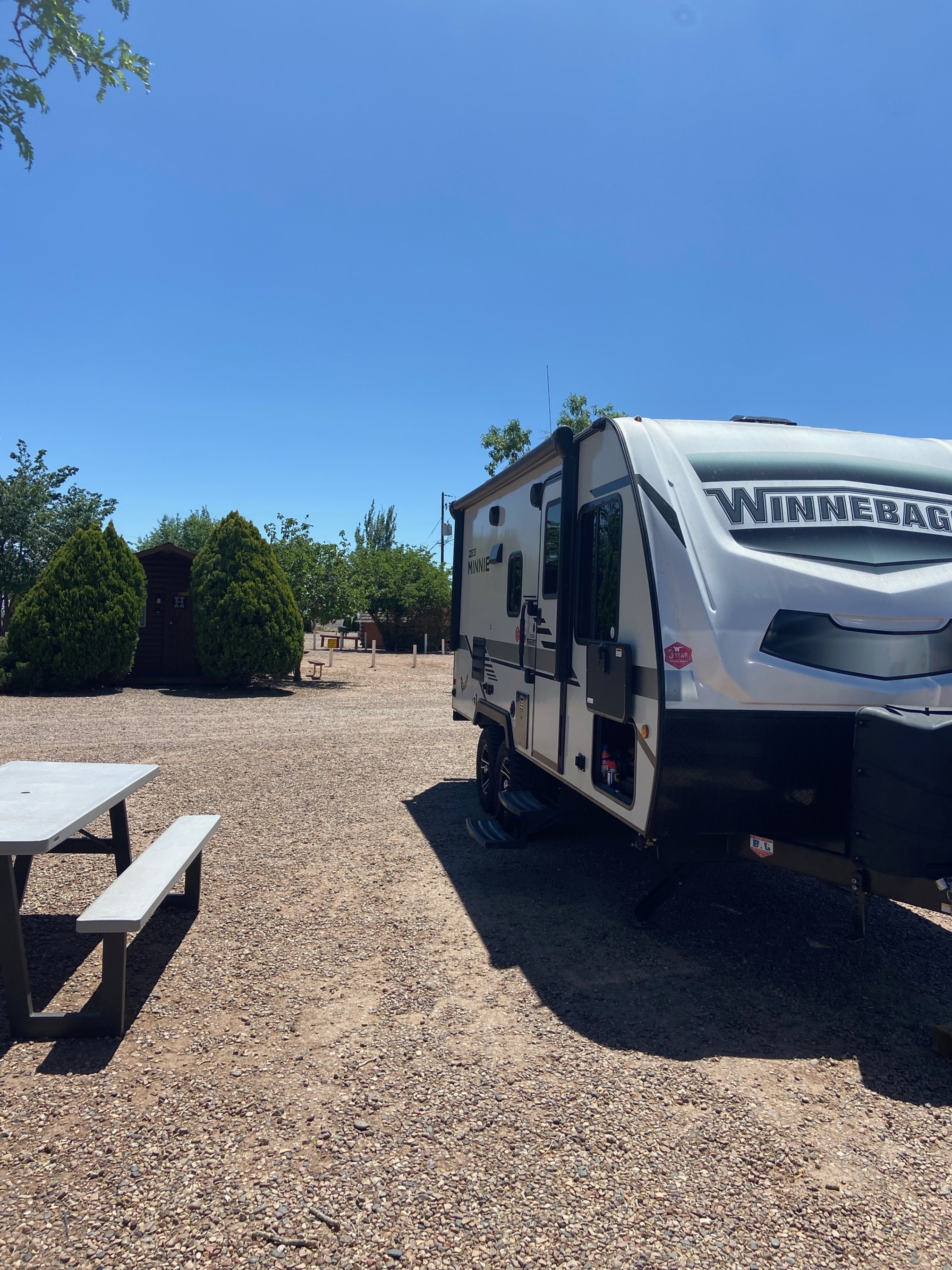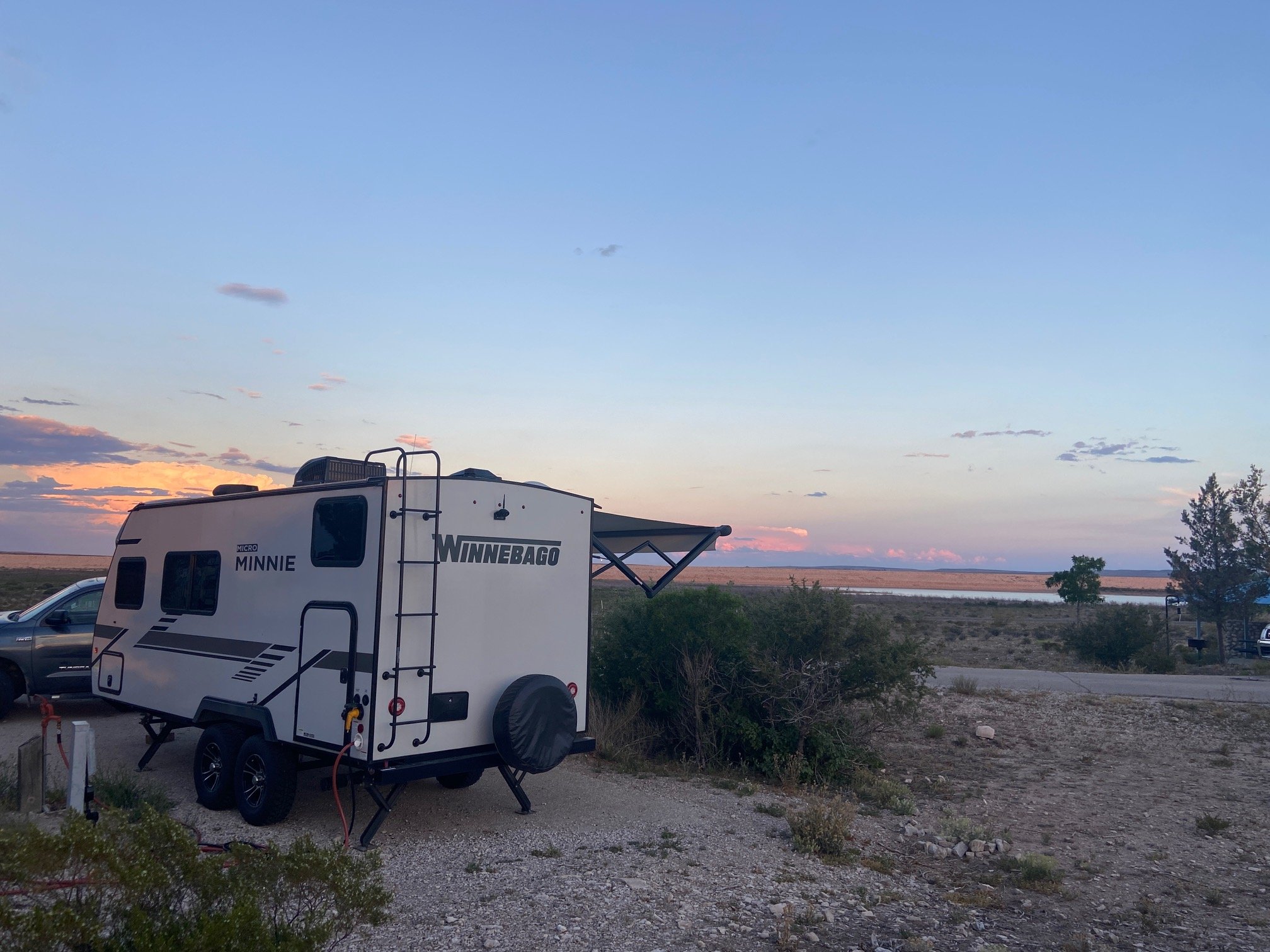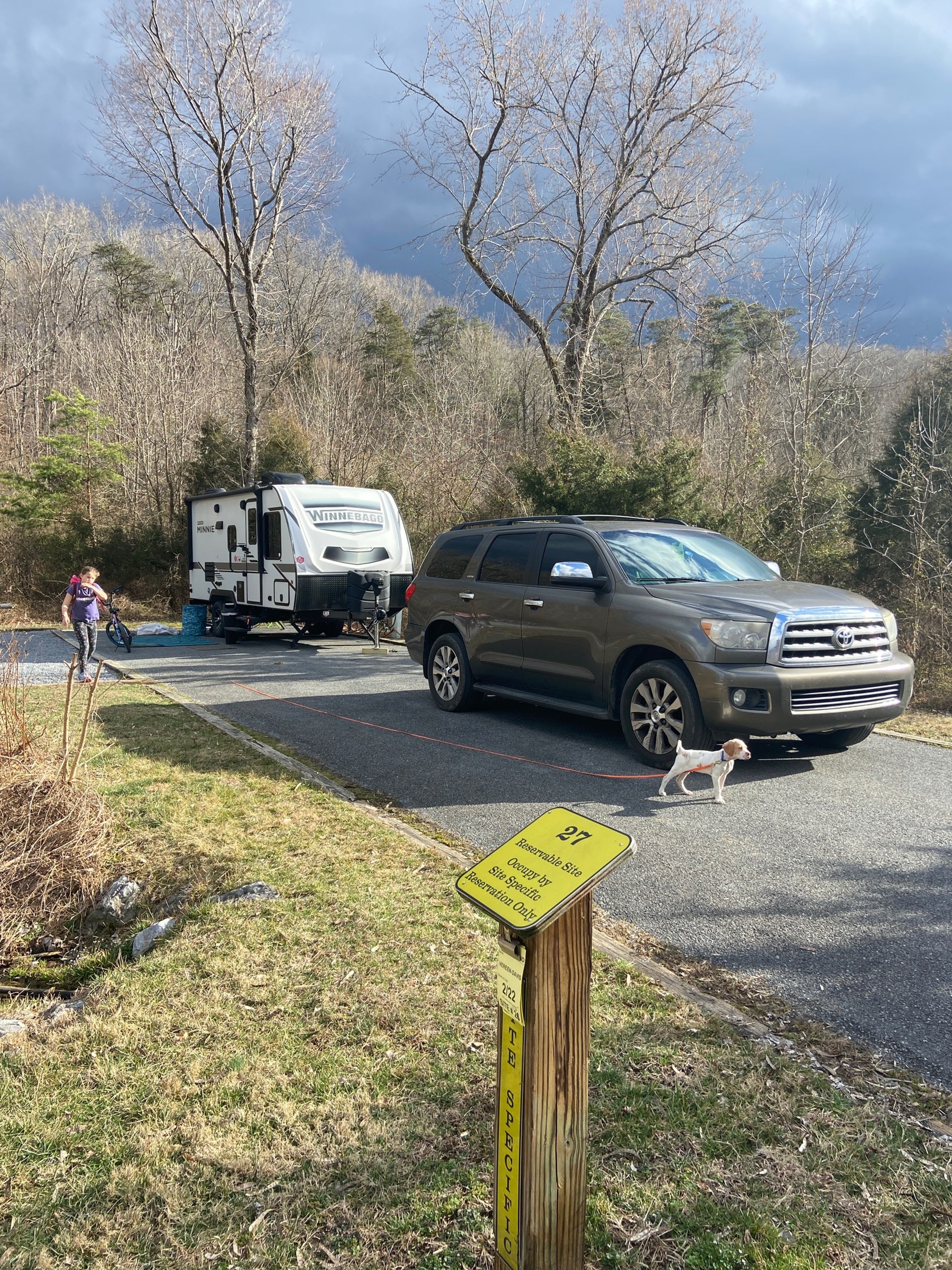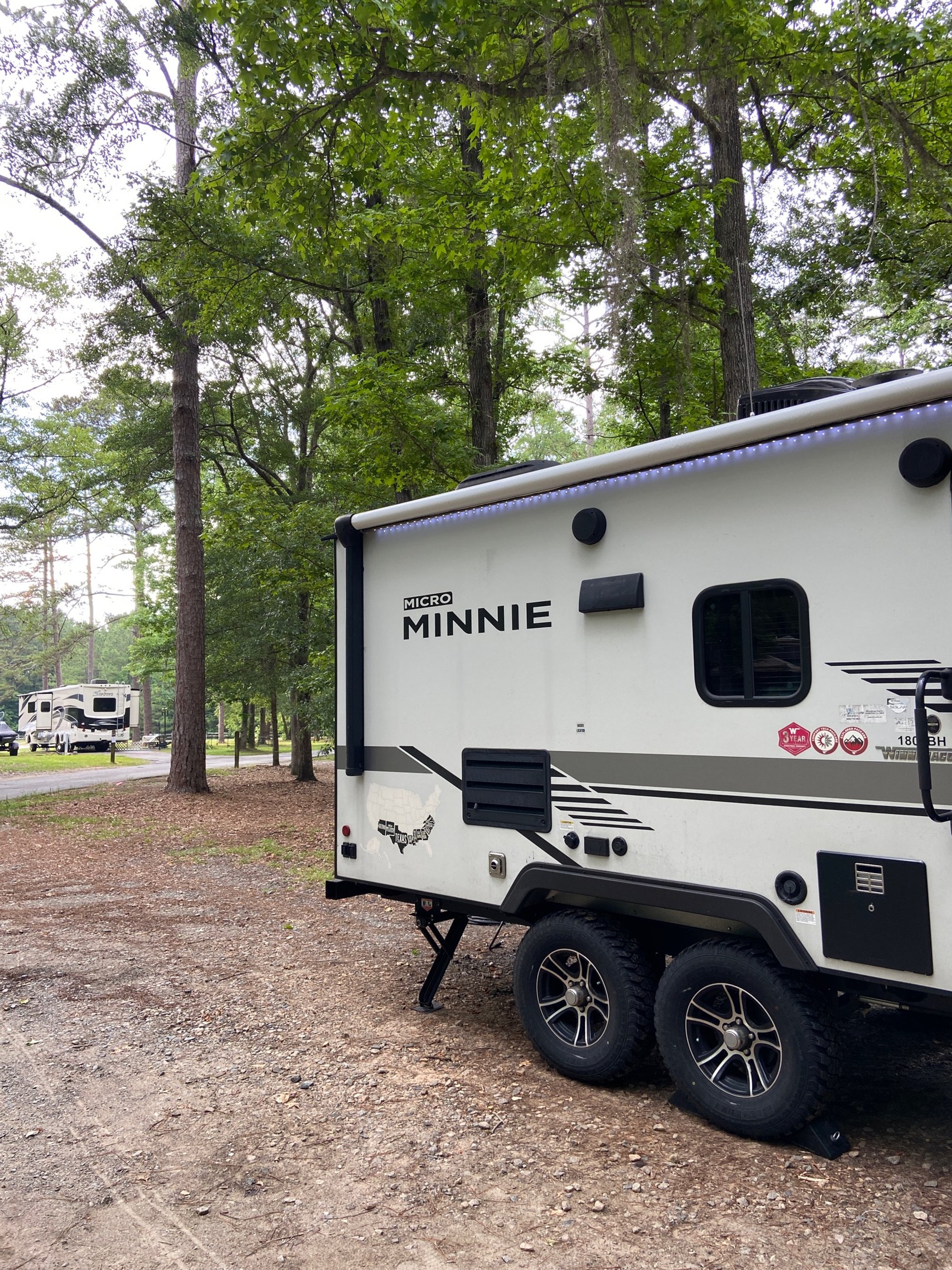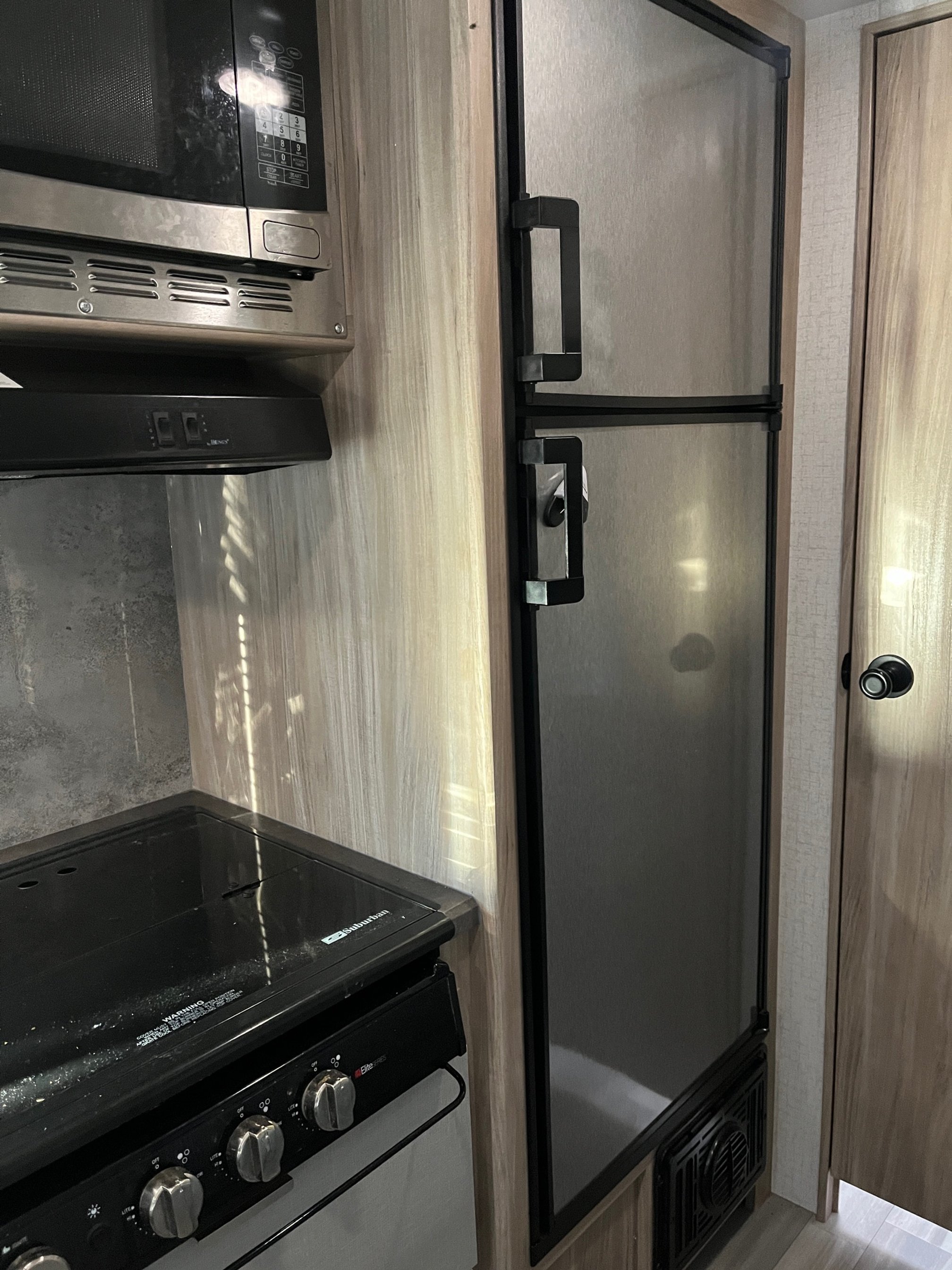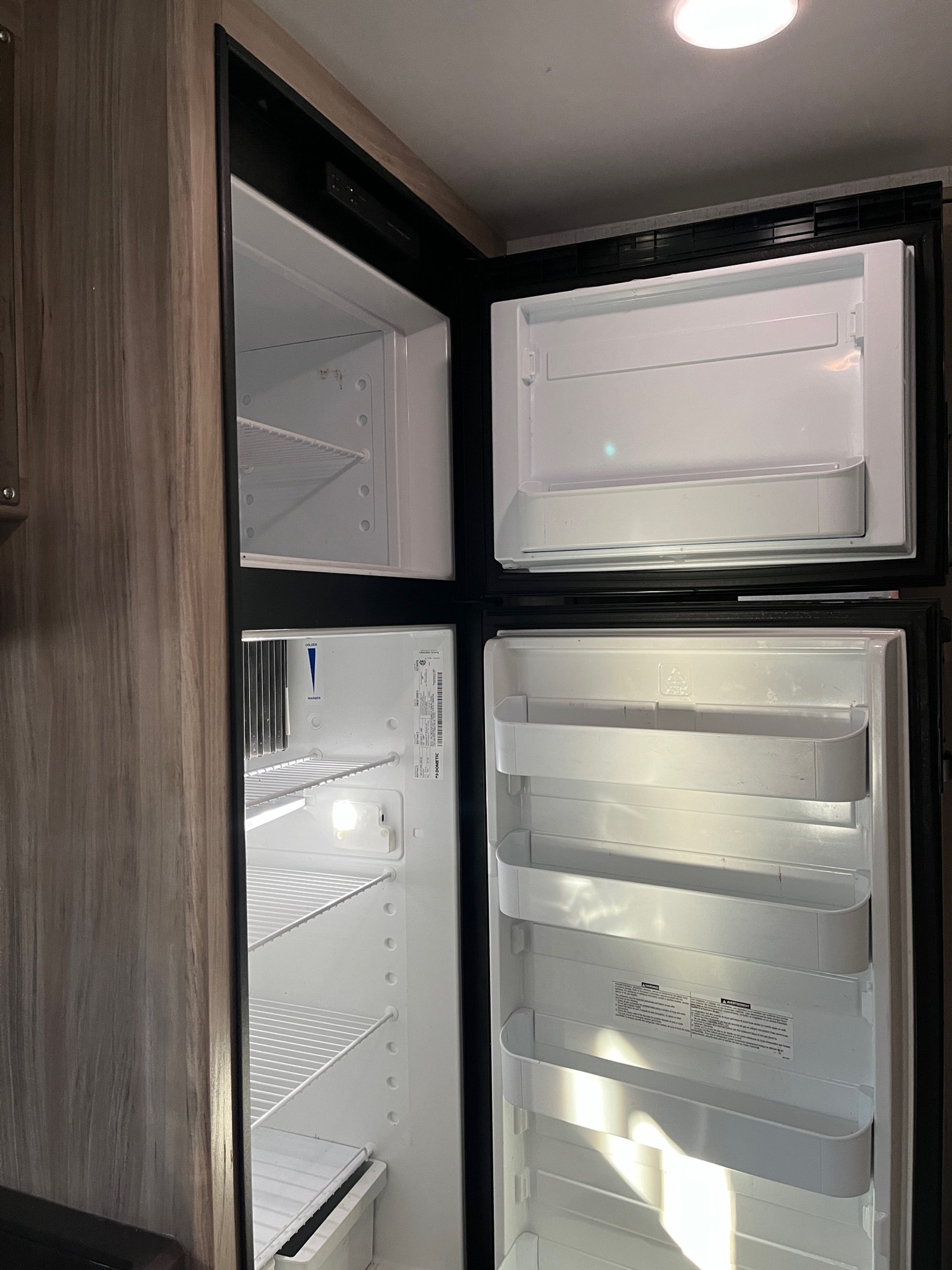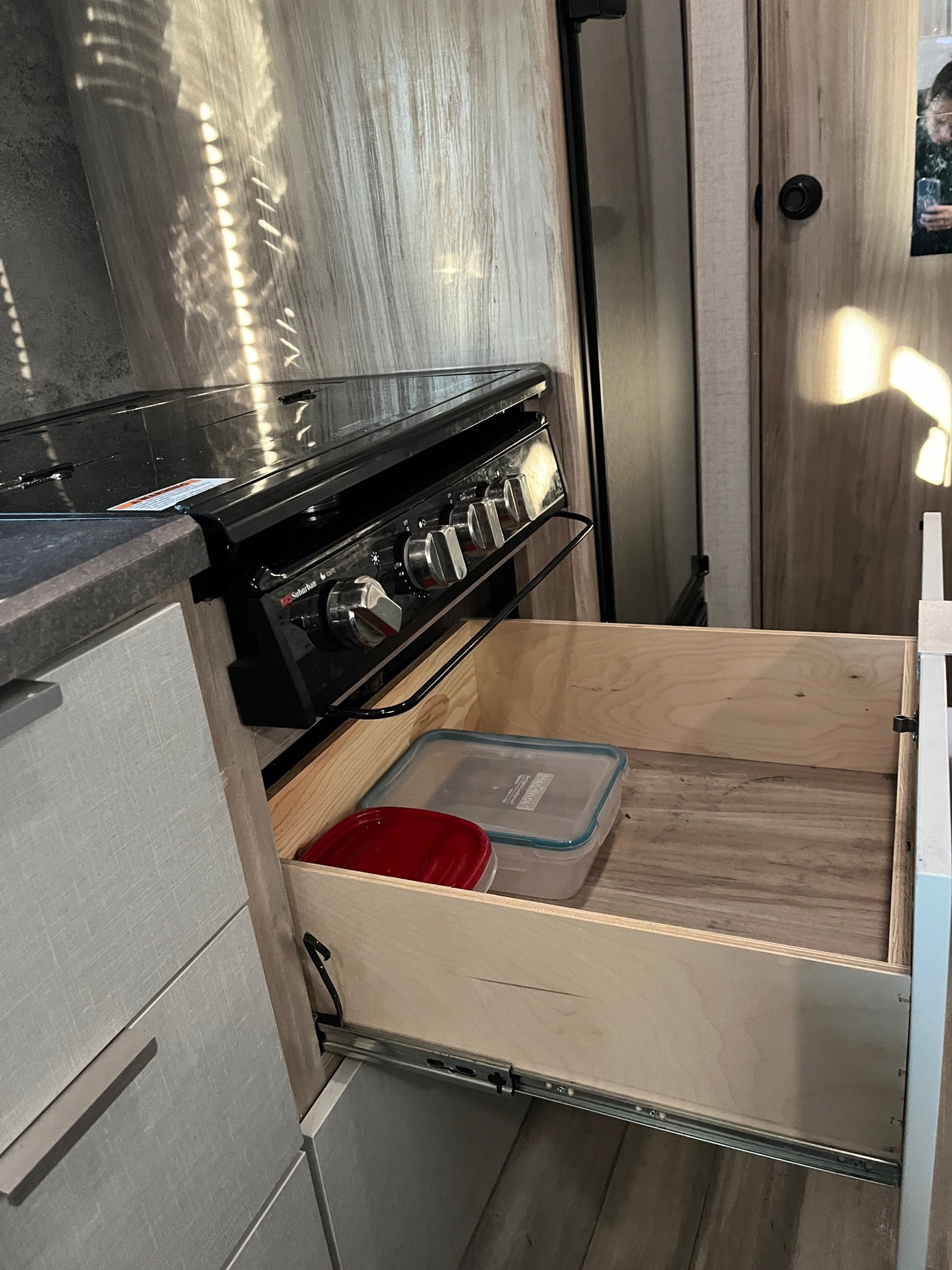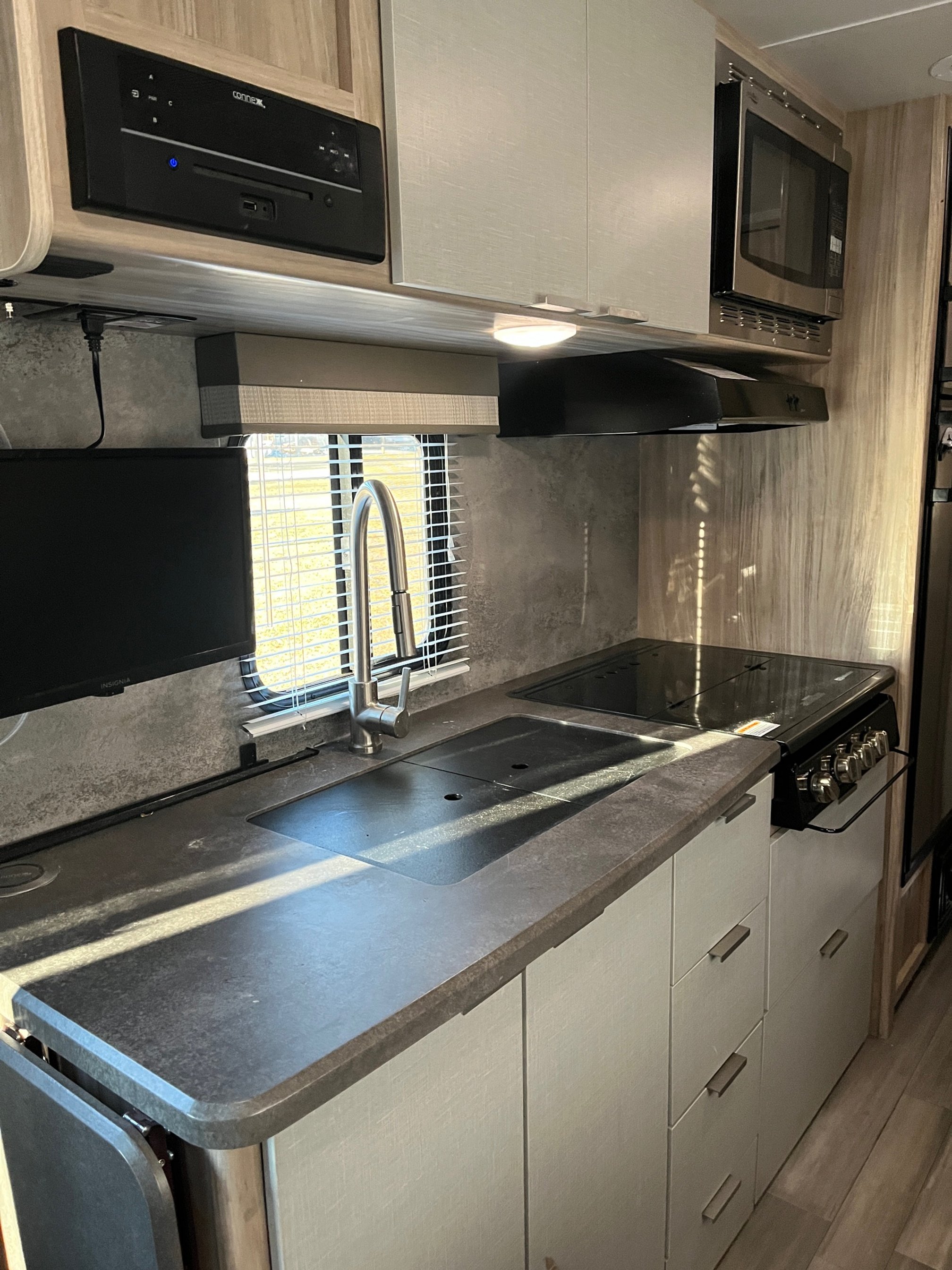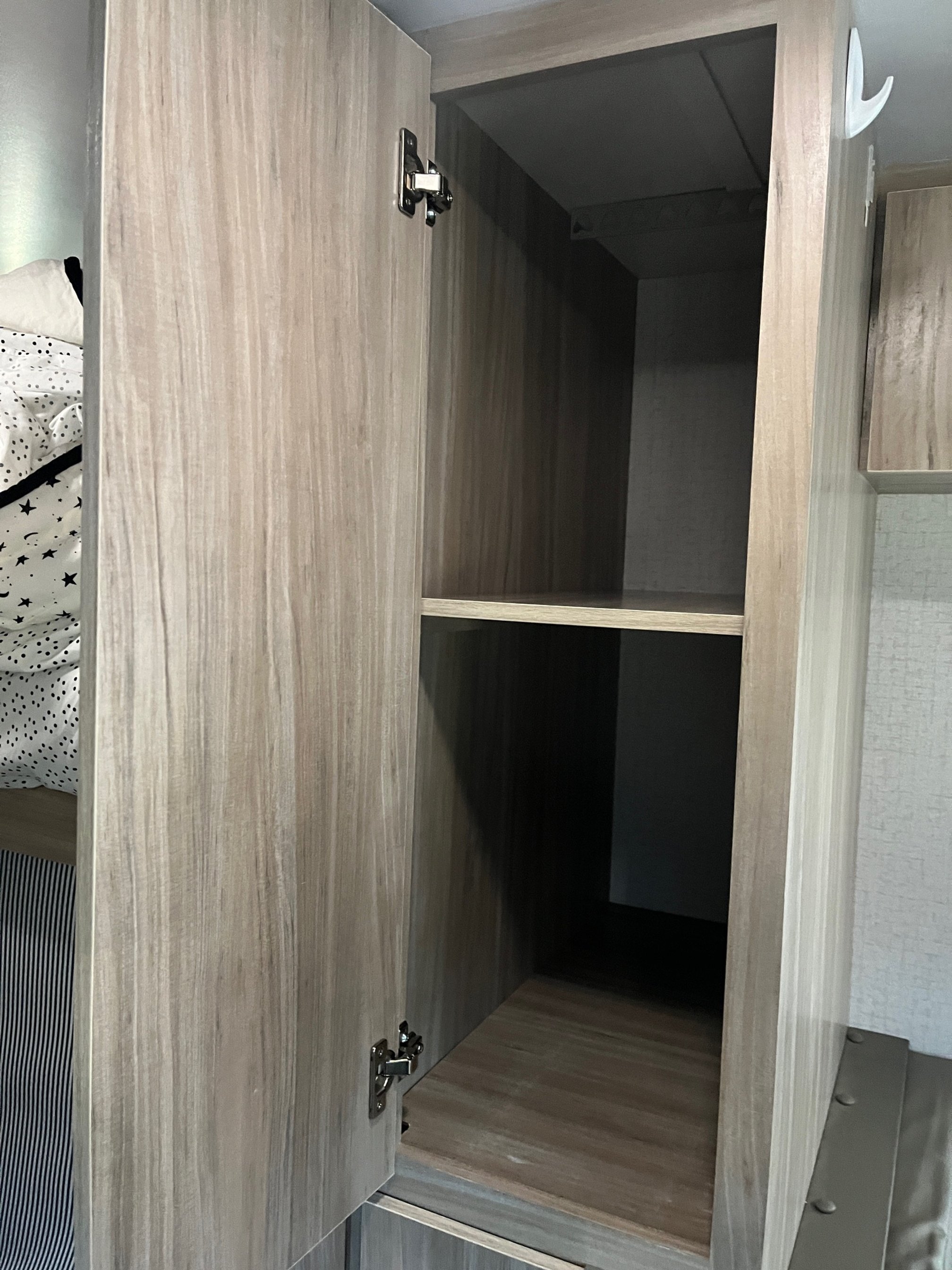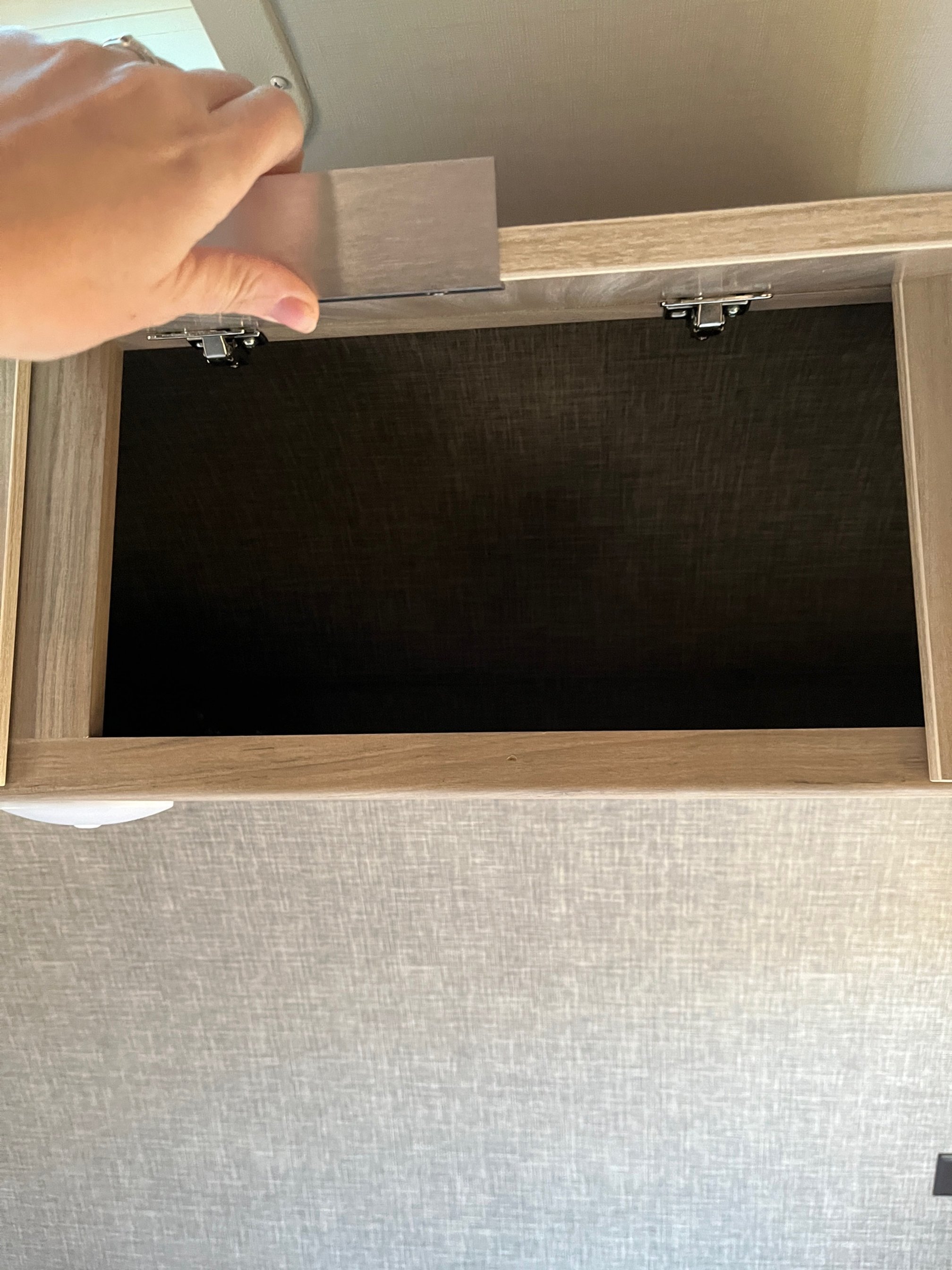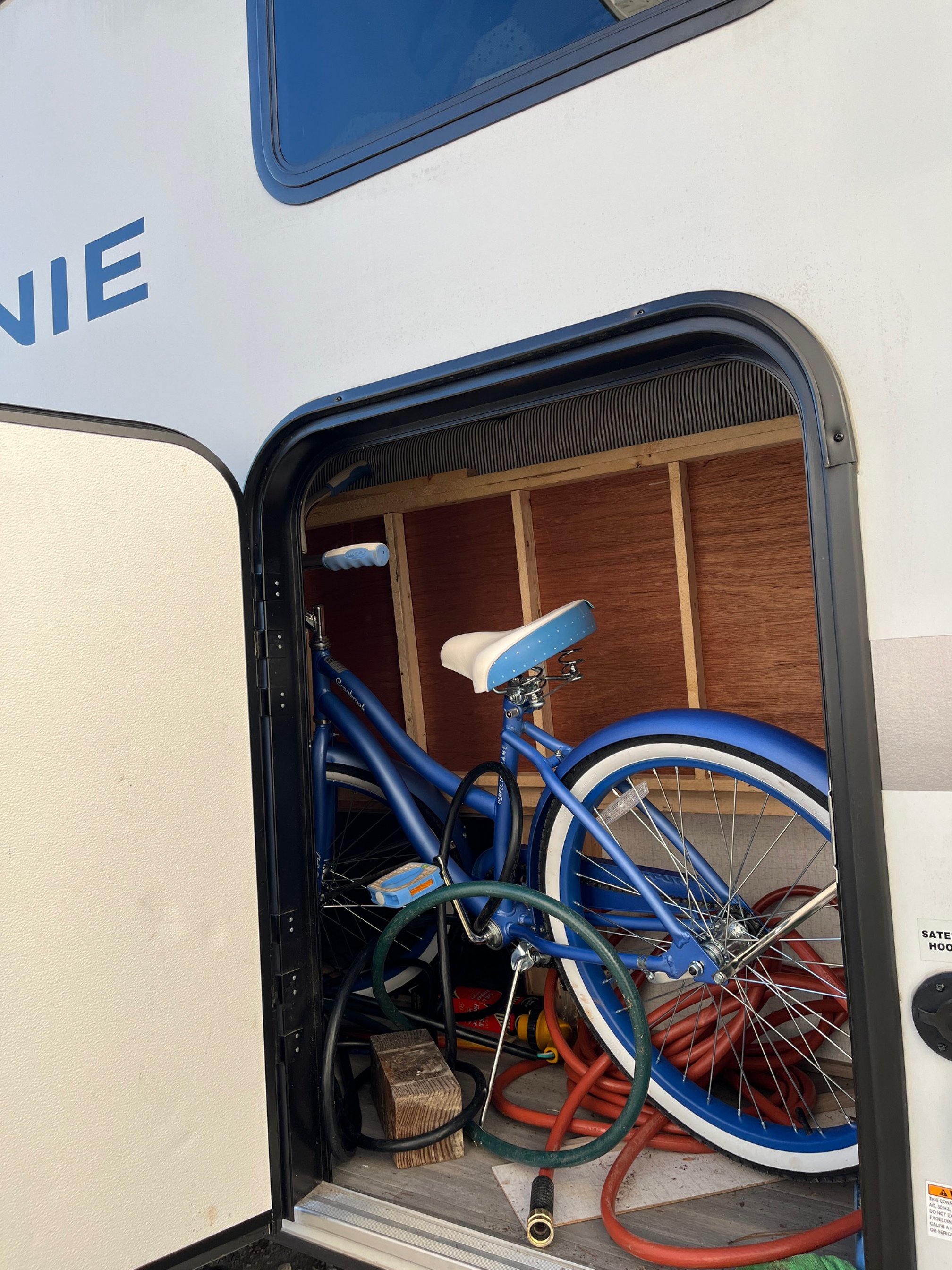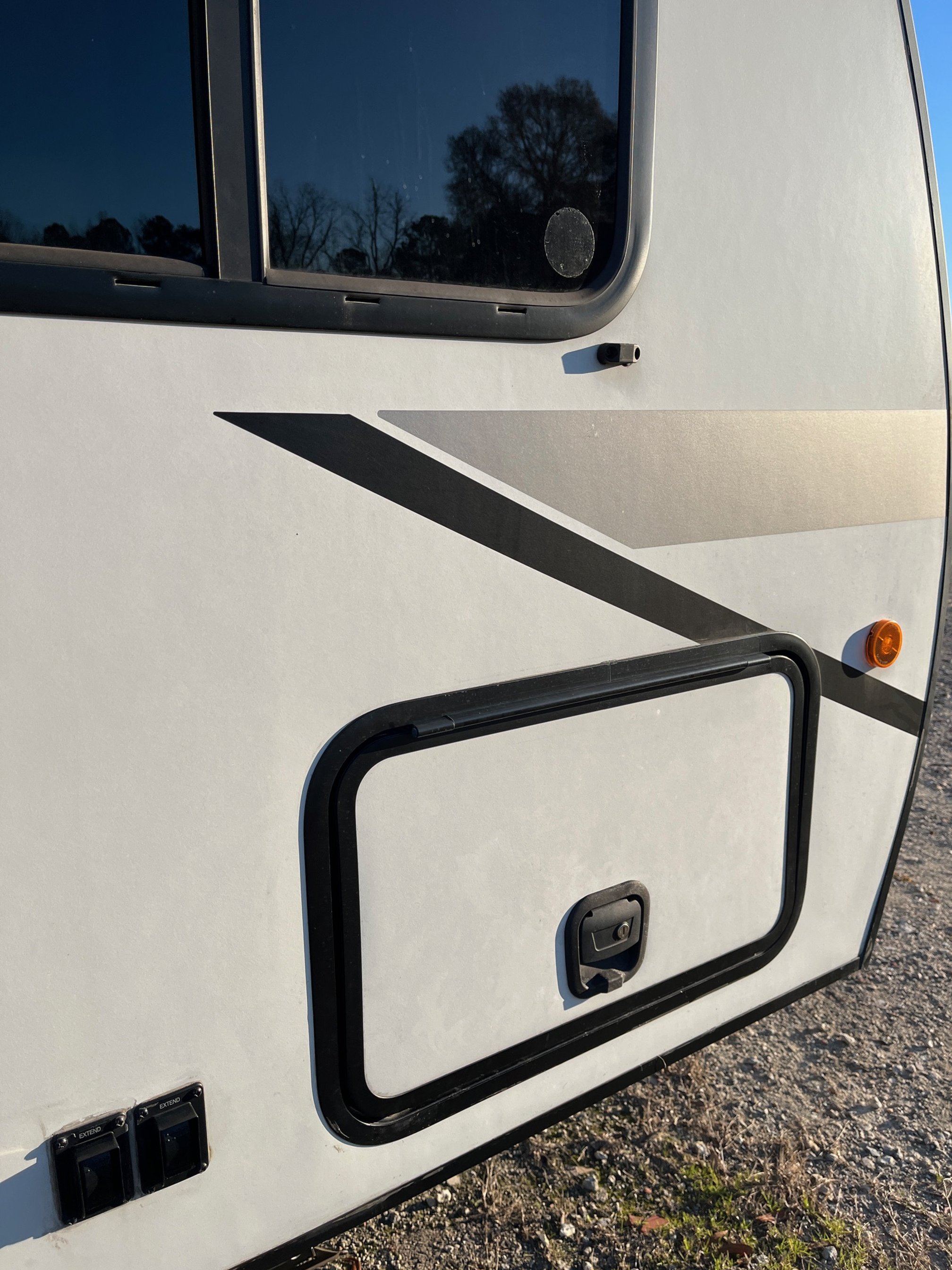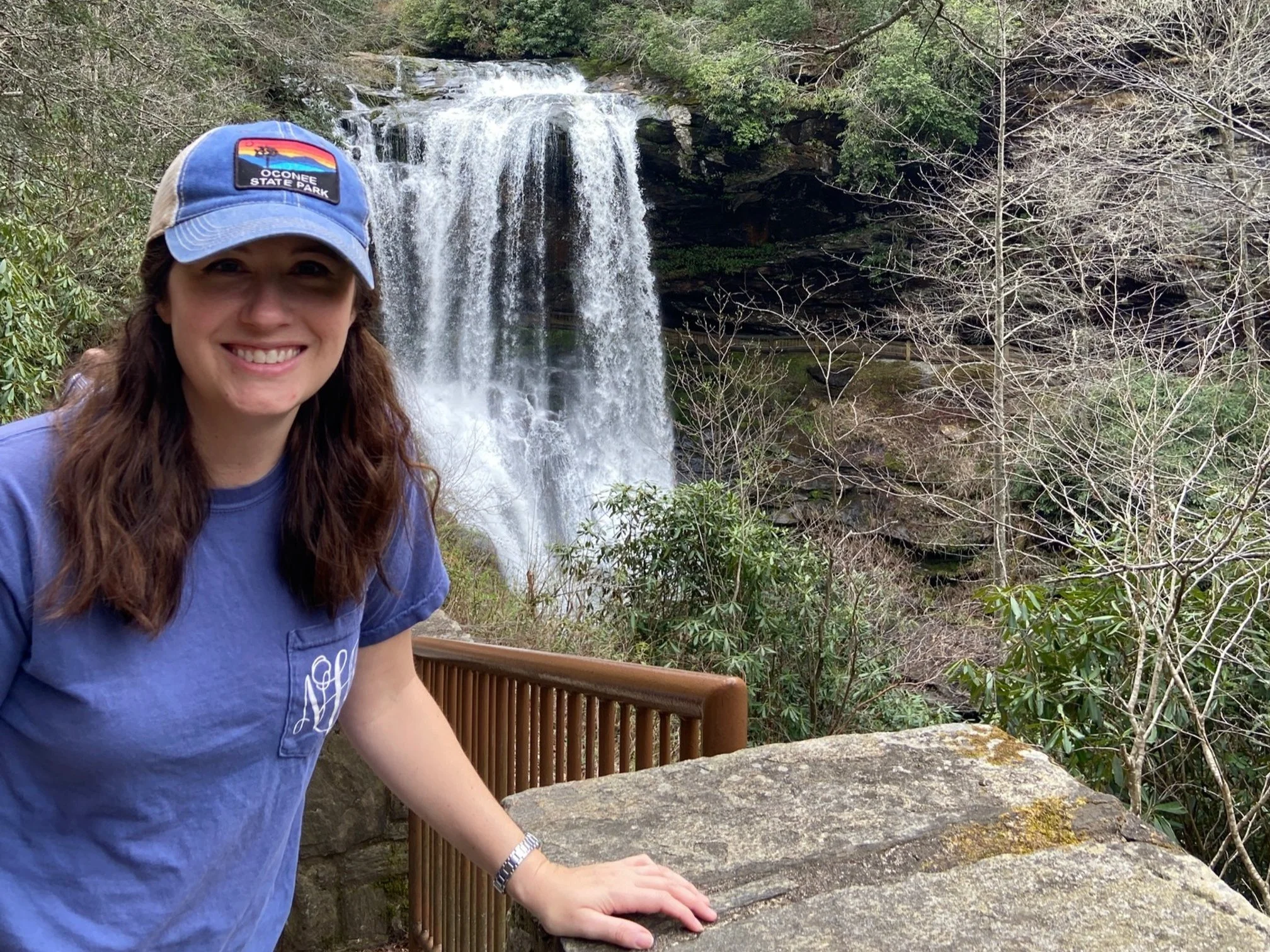Winnebago Micro Minnie 1800BH Review
If you’re considering a Winnebago Micro Minnie 1800BH, this review will walk you through the pros and cons of this travel trailer.
Compact but packed with features, the Micro Minnie trailer series can fit in just about any campsite. This compactness makes it great for couples or families who want to stay in state and national parks that have strict trailer length limits.
The 1800BH style is great for small families, thanks to the bunk beds in the back of the trailer.
My family and I have owned this trailer model for over a year, during which we’ve hauled it well over 3,000 miles from South Carolina to Arizona to Virginia and back again.
Below, I’ll walk you through the pros and cons of this travel trailer, share my thoughts on the included features, and provide tips on how to get the most out of the Micro Minnie 1800BH.
The kids and I in front of our Micro Minnie 1800BH as we get ready to leave the last stop of our 7-week road trip from South Carolina to Arizona
This post contains affiliates. If you purchase through the links below, I will receive a commission at no charge to you.
Micro Minnie 1800BH Complete Review
As with any travel trailer, the Winnebago Micro Minnie 1800BH has some excellent features—and a few things that aren’t so great.
While we are part-time campers, we do go on at least 1 multi-week road trip in the camper each year, so we will spend anywhere from 3 to 7 weeks straight living in the camper during each trip.
That sort of longer term habitation has allowed us to really stretch the limits of this little camper and get a complete feel for what design features work and which might’ve needed more time on the drawing table.
Micro Minnie 1800BH vs. 1700BH trailers
PIN ME!
In the Winnebago Micro Minnie line, there are 2 options that are nearly identical: the 1800BH (which we’re focusing on here) an the 1700BH.
The interiors share a bunkhouse near the single bathroom, a front sleeping area and a small, galley-style kitchen. They also have front and back storage, and an interior 4-person dinette.
So, what’s the difference?
The biggest difference between the Micro Minnie 1800BH and the 1700BH is that the 1800BH comes with a dual axle, while the 1700BH only has a single axle.
You might wonder why a 21 foot trailer needs a dual axle, and that’s an honest question.
Even the smaller trailers like ours can benefit from a dual axle as that extra set of wheels provides additional support for your trailer, better stability while you’re in the trailer, and a safer towing experience.
Plus, it gives you the piece of mind that—if you should have a tire blow out on the interstate—you’ll be able to slowly limp to a safe place to change the tire rather than being forced to make repairs on whatever road shoulder you’re closest to.
I’m particularly won over by that perk of the dual axle as I think I’m permanently scarred from our trip to the Outer Banks with our previous trailer, a pop-up, where I blew a tire on the way there and the other on the way back.
In fact, that experience was one of the major reasons why we decided to upgrade to the Micro Minnie 1800BH. Read more in my head-to-head pop up vs. travel trailer comparison.
Micro Minnie 1800BH Quick Stats
Dry Weight: 3821 lbs.
Fresh water tank: 31 gallons
Grey water tank: 25 gallons
Black water tank: 25 gallons
Sleeps: 5
Height: 10’5”
Length: 21’ 11”
Power: 30 amp
Pros of the Winnebago Micro Minnie 1800BH Model
There’s a lot to love about the Micro Minnie 1800BH.
Here are a few of the things that won us over to this specific model
Compact Size
At just under 22 feet long and 7 feet wide, this trailer can fit just about anywhere.
Since we love to frequent both national park and state park campgrounds, we knew that we’d need a smaller trailer to be able to consistently fit within the notoriously small campsites at those locations.
I love not having to worry about whether my trailer will fit once we get to a campsite.
Plus, the smaller size means that I can drive it myself, which is a huge deal for someone with major spacial awareness issues like I have.
In fact, our Micro Minnie is less than 2 feet longer than our previous trailer, a Coleman Bayside pop-up.
That similarity made for a seamless upgrade as there’s very little difference in driving while towing the pop-up versus the Micro Minnie.
Since the Micro Minnie is lightweight, you can tow it with a Toyota Tundra, Toyota Sequoia, or Ford FJ.
We started out with both a Toyota Sequoia and a Toyota Tundra as our tow vehicles, but have now dropped back to a Ford F150.
In all 3, it barely felt like we were towing anything at all, though we get a lot better gas mileage in the newer Ford F150 than we did either of the older Toyota vehicles.
Kid Friendly
Forgive my bed making skills! It’s hard to get those hospital corners in the bunk beds.
The fact that our trailer can sleep 5 people was really appealing to us.
While at least 2 of those people are going to need to be under about 5’3”, that still provides great options for a growing family who’d like to go camping.
There are 3 sleeping areas: the bed at the front of the camper, the converted dinette table, and the bunk beds in back.
For a family like ours with 2 adults and 2 preschool/elementary aged kids, that set up is excellent.
We don’t even have to use the convertible dinette—but the kids love that bed for some reason, even though they each have a bunk.
The Micro Minnie 1800BH allows us to fit our family into a compact space, while still allowing our kids the option of their own areas.
We’d seriously considered a Class C RV in our search, but we just couldn’t get around the fact that the kids would need to share the space above the driver.
The Micro Minnie was an excellent solution that still kept our overall footprint to a manageable size.
The dinette that can be converted into another twin(ish) bed
Little to No Learning Curve
Since there aren’t any slide outs or special equipment requirements, the Micro Minnie 1800BH is easy enough for even beginners to make work.
While I grew up camping, both in tents and in my grandparents’ 1970s Grumman RV, I hadn’t ever owned a hard sided travel trailer until our Micro Minnie purchase.
After the steep learning curve the came from the leap between tent camping with kids and the pop-up camper, I was expecting a similar issue with the difference between the pop up and the Micro Minnie.
Nope! The first time we took the Micro Minnie camping, my husband and I finished setting up so quickly that we kept walking around trying to figure out what we’d forgotten to do.
Compared to the set up with our pop-up, which required pulling out beds, hooking up electric and water, setting up the kitchen area, making beds, etc., the Micro Minnie literally lets us back into our spot, set the chocks, unhook from the truck, and then pop in the water, electric and sewer.
If I can do all of that by myself in the less than 30 minutes, I know you can, too.
Boondocking Capabilities
Our Micro Minnie 1800BH came with integrated solar energy, which was a huge draw for us.
Thanks to a solar panel on the roof of our camper that’s fully integrated with our camper battery, we are able to run the lights even when we’re not tied to shore power.
This portable power source ensures that we can use the water pump and see in the camper during quick bathroom or snack stops.
The fresh water tank is large for a trailer of its size, and we will fill it up when we know we’re boondocking or heading to a campground without full amenities.
The longest we’ve gone without needing a fresh water fill up or grey/black tank is 4 days, and that’s with 2 adults and 2 kids using the bathroom facilities, washing dishes, and the like. We could probably go longer if we’d really tried to conserve our water usage.
These features make camping at Cabela’s overnight or at a similar big box store super easy. It also opens up a world of dry camping options like Harvest Hosts, BLM land camping, and more.
Great Kitchen Appliances
For such a compact kitchen, the Micro Minnie has some great features.
We have a nicely sized refrigerator/freezer unit that has a 10.3 cubic feet capacity, which means we can pack soft drinks, sandwich meat, veggies, juice boxes, and more.
There are 3 wire shelves, 2 plastic drawers, and 4 door shelves in the refrigerator for maximum organization.
When I traveled with my kids out to Arizona and New Mexico in the camper, we could easily go 5 or 6 days between grocery store visits. (We also had either my dad or my husband with us the entire time, making that all the more impressive since 2 adults and 2 kids were eating off the available food at any given time.)
Whenever I’m packing the food for a trip, I’m always pleasantly surprised at how much the refrigerator will hold.
My only complaint is that there’s no place for a 2-liter bottle or gallon milk jug to go without being placed on its side. We get around this by buying 2- half gallons of milk or individual cans of soft drinks.
The freezer has a wire shelf dividing the space, and it’s been great for keeping frozen pre-made meals, breakfast sandwiches, and bags of veggies. I do my best to make meals and snacks ahead of our trips, so we spend more time having fun and less time in the kitchen, and the freezer space makes that possible.
The other star of the kitchen is the convection oven/microwave combo.
It’s rare to find any oven in a travel trailer this size, though most come with a microwave. I love that we can switch back and forth between these functions to easy heat up frozen breakfast biscuits or toast sandwich bread.
Convertible lower bunk/storage area
What the bunk area looks like when the bottom bunk is up for extra storage. Storage is accessed from the outside.
This feature was one we found in several travel trailers, and it was a feature that we ended up having to have.
I love being able to put the kids’ bikes or scooters in the storage space that’s made available when the bottom bunk is placed in an upright position. We also store our water hose, electric hookup connector, and electric converter pigtails in this space for easy access during set-up.
The fact that we still have one usable bunk even with the storage space is full means that both kids can sleep while we boondock on the way to a location—1 kid stays on that top bunk, while the other sleeps on the converted dinette bed.
The storage space is large enough to fit my daughter’s 22” bike and our son’s 16” bike, but barely. Usually, we’ll put the larger bike here and the smaller bike in the back of our tow vehicle since that’s easier.
More storage elsewhere in the camper:
Off-roading tires
These are large, rough-and-tough tires that provide plenty of options for us on the road.
Unlike the paper thin tires that came standard with our pop-up, the offroading tires that came with the Micro Minnie have stood up to all sorts of road conditions without any issue.
Plus, we don’t hesitate to take the camper down a dirt road to BLM dispersed camping with the tires on the camper and my husband’s similarly structured tires on the Ford F150.
Of course, you always want to keep track of how many miles you put on your tires, and consistently check the tire pressure on your trips. The tires on the Micro Minnie, however, should give you a bit more peace of mind than the cheaper, flimsier tires on other models.
Cons of the Winnebago Micro Minnie 1800BH Model
Of course, nothing’s perfect, even my beloved travel trailer.
Here are a few of the things we wish we could change about the Micro Minnie 1800BH (and, when we could, we have changed!).
Loud A/C
At night, when we’re getting ready for bed, we’ll often drop the A/C by a few degrees—or, in some cases, turn it on for the first time all day when the weather is nice.
And every time, I am surprised at how loud that A/C unit is.
On one hand, that loudness is a positive for me, as it keeps me from hearing my dad snoring at the end of the trailer when he’s traveling with us.
But on the other hand, it’s very distinctive if you’re not used to sleeping with white noise.
There’s not an easy way around this issue, as an electric fan plugged into the wall just doesn’t cool things down as well. (And in some cases, is just as loud.)
We’ve made do with it, but the white noise aspect is something to be aware of.
The original door lock wasn’t secure.
The upgraded door lock
This was a known issue as our friend who sold us the camper made us aware of it during the sales process. She’d found this defect out the hard way when she was driving down the road only to see the camper door coming open. Luckily, she didn’t lose anything.
While the folding support bar will keep the door from flying all of the way open, you really don’t want to be jetting down the highway with your door even a few inches open.
After many attempts at fixing the original door latch to no avail, we decided to upgrade to a keypad lock. We got one by RV Lock, and it has fixed the original issue fully.
Tiny shower
In the 14 months or so that we’ve owned the trailer and the thousands of miles we’ve hauled it, we’ve used the shower as a full shower experience once.
It’s SMALL at only 2 feet wide and 3 feet long.
I did my best to get as much of the bathroom and shower into this photo, but it’s hard due to the lack of space.
We use it regularly to keep items in storage while we’re moving from place to place, and it’s also in heavy rotation for quick rinse-offs after muddy trails or sandy beaches.
But the only person brave enough to commit to a complete shower in there is our 10-year-old.
We are usually staying some place that has a bath house, and I’d much rather walk a hundred feet to a full sized shower than squeeze myself into our tiny shower.
If you’re taller than about 5’10”, you’re also going to have issues just standing up straight in the shower since the ceiling isn’t a high one.
However, I know that a sub-22’ trailer is only going to be able to fit so much, and I’m happy that they used the space as effectively as possible. Having a bigger shower would mean giving up space elsewhere, so the current layout is fine.
Issues with black tank pull
The ONLY issue we’ve had that made us really annoyed had to do with the black tank pull.
When we were at the Tucumcari KOA in New Mexico, we realized that our black tank pull felt completely bound up. No matter how hard my dad or I pulled, wiggled, or jerked on it, the pull would not give.
We were exhausted after 11 hours on the road that day, so we decided to leave it for the next campground in Texas where we’d have a longer visit.
When we arrived at the Vineyards Campground in Grapevine, Texas, we had a mobile mechanic to come out and look at it, and he confirmed what we suspected: that the long metal pull for the black tank had gotten slightly bent.
He did what he could to help us straighten it back out, but nothing really worked 100%.
When my husband joined us on that trip, he also looked at it and determined that he could fix it, but it would have to wait until we got home.
We’ve since fixed it, but it was a difficult and sweaty process. My husband had to cut a hole into the protective liner at the bottom of the camper to get to the pull system. Then, he had to rethread a new pull shaft into the space.
After researching this problem on the Winnebago Owners facebook group, I’ve found that this is a common issue, so be careful.
The front bed is smaller than is comfortable.
While I’m grateful to have space to sleep 5, you really have to like whomever you’re sharing that front bed with.
It’s advertised as an RV queen, which is really a standard full by measurement.
We’re used to sleeping on a king bed at home, so that downgrade to a full while we’re on vacation is tough.
Sometimes, the lack of space is just too much, and one of us will retreat to a free bunk to escape the snoring or wiggling.
There’s not much that Winnebago can do about the bed size without drastically reworking the interior or making the entire trailer larger.
But I can still complain about it. If we ever upgrade to a larger trailer, I’ll be looking for one with a queen or king.
The bunk beds are short.
As I mentioned previously, my husband or I will occasionally sleep in one of the bunk beds while one of the kids uses the top bunk and the other uses the converted dinette.
I’ve only got a few inches to spare when fully stretched out in the bottom bunk bed.
I was the world’s most selfless daughter when traveling with my dad last summer, and I gave him the big front bed while I took the lower bunk bed for the duration of our time in New Mexico and Arizona.
That was partially me being nice and partially me being practical because there’s no way my 6’ tall dad would’ve been able to fold himself into that lower bunk.
I’m 5’7” and I can just get myself in that bottom bunk with a little bit of room left over for my toes to move around.
My husband is 5’10” and his feet fully touch the back wall when he’s sleeping in the bottom bunk.
I can’t sit up in the bottom bunk, but I didn’t find that to be much of an issue since I literally just used it to sleep.
The bottom bunk does have its own light, but no window.
There’s absolutely no way that I or any other adult could get in the top bunk. I’ve tried, but there’s not enough room to lift up into the space and swing my legs around.
If the camper’s interior had to be expanded by another foot, I’d divide that space between the bunk sleeping space and that front sleeping space to make things just a little more comfortable.
Electrical issues with stabilizers
This was another known issue that our friend shared with us before we bought it.
For whatever reason, the electrical line to the back stabilizers wasn’t consistently connected, and, therefore, they only came down part of the time, and sometimes in fits and spurts.
We’ve tried to fix it, but needed more supplies, and frankly, we’ve been so busy that we haven’t come back around to it.
Hand cranking the stabilizers with the included cranks really isn’t bad, so that’s part of the reason why we’ve been slow to fix the issue, too.
Get prepared for every adventure with this list of most forgotten camping items and our downloadable camping packing list.
My Family’s Experience with the Micro Minnie 1800BH
While this information is anecdotal, I thought that sharing my family’s experiences with this trailer model would be helpful for anyone purchasing one.
We purchased ours used from a friend who lives locally. We knew that she’d taken excellent care of the trailer as she’d only used it a handful of times, mostly at nearby South Carolina state parks.
So, the trailer came to us nearly new and with all of the original factory features.
We’ve upgraded and added several things to the camper since then—many of which are outlined in my travel trailer must haves round-up.
Even with those changes, we haven’t done that much to the Micro Minnie, and inside and out, it looks pretty similar to the day we brought it home.
Overall, the travel trailer has been a wonderful tool for us on the road, and it has improved our travels immensely. More than ever, we have comfortable places to sleep, the ability to make nutritious, inexpensive food on the road, and have a place to call home no matter where we are.
The Micro Minnie 1800BH is particularly great for our family thanks to its layout, storage, and easy of use.
We’ve used it consistently throughout the time we’ve had it so far with many more plans to take it even more places.
Most importantly, it is reliable. Everything that we’ve had issues with has had a fairly easy workaround, except for maybe that black tank issue (which was something we could fix, just not in a campground 1500 miles from home).
My last piece of advice is to join the Winnebago Micro Minnie Owners Facebook group! This community knows everything that there is to know about Micro Minnies and their upkeep, and I’ve poured over their advice on more than one occasion.
Final Thoughts on the Winnebago Micro Minnie 1800BH Model
I’d buy this trailer over again, even knowing what I know now.
It’s a solid trailer with helpful, easy to use features. You could easily use this as your go-to beach vacation camper, your weekend hunting lodge, or your family’s first foray into road tripping.
While the shorter bunk size will keep this from being a top pick for families with older kids, the travel trailer’s overall size and options are excellent for retirees, families with younger kids, or couples who want flexible sleeping and storage space.
You don’t need to be a camping guru to quickly learn how to hitch, pull, and set-up this trailer, which is another feature I love about it.
Plus, your tow vehicle doesn’t have to be huge: a Ford FJ or Toyota Sequoia can pull this trailer without trouble.
Overall, it’s a great entry camper at a good solid price point from a name that’s well known in the RVing world.


